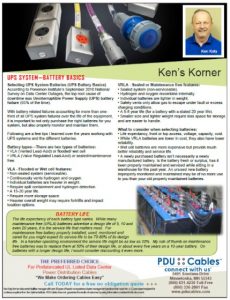KEN'S KORNER - UPS System Battery Basics
Selecting UPS System Batteries (UPS Battery Basics)
According to Ponemon Institute’s September 2010 National Survey on Data Center Outages, 95% of the companies surveyed had experienced unplanned outages in the prior two years, with 88% citing the loss of primary power as the culprit and experiencing an average downtime event lasting 107 minutes per outage. The survey also indicated the top root cause of downtime was Uninterruptible Power Supply (UPS) battery failure (65% of the time). UPS Systems - Battery Basics
With battery related failures accounting for more than one-third of all UPS system failures over the life of the equipment, it is important to not only purchase the right batteries for you system, but also properly monitor and maintain them.
Following are a few tips I learned over the years working with UPS systems and the different batteries.
Battery types
There are two types of batteries:
• VLA (Vented Lead-Acid) or flooded/ wet cell
• VRLA (Valve Regulated Lead-Acid) or sealed/maintenance free.
VLA - Flooded or Wet cell features:
• Non-sealed system (serviceable).
• Continuously vents hydrogen and oxygen.
• Individual batteries are heavier in weight.
• Require spill containment and hydrogen detection.
• A 15-20 year life.
• Require more storage space.
• Heavier overall weight may require forklifts and impact location options.
VRLA - Sealed or Maintenance free features:
• Sealed system (non-serviceable).
• Hydrogen and oxygen recombine internally.
• Individual batteries are lighter in weight.
• Safety vents only allow gas to escape under fault or excess charging conditions.
• A 5-8 year life (for a battery with a stated 20 year life).
• Smaller size and lighter weight require less space for storage and are easier to handle.
What to consider when selecting batteries:
• Life expectancy, front or top access, voltage, capacity, cost.
• While VRLA batteries are lower in cost, they also have lower reliability.
• Wet cell batteries are more expensive but provide much better reliability and service life.
• A newly purchased battery isn’t necessarily a newly manufactured battery. Is the battery fresh or surplus, has it been properly maintained and serviced while sitting in a warehouse for the past year. An unused new battery improperly monitored and maintained may be of no more use to you than your old properly maintained batteries.
Note:
The life expectancy of each battery type varies. While many maintenance free (VRLA) batteries advertise a design life of 5, 10 and even 20 years, it is the service life that matters most. For maintenance free battery properly installed, used, monitored and cared for you might expect its service life to be 70-80% of its design life. In a harsher operating environment the service life might be as low as 20%. My rule of thumb on maintenance free batteries was to replace them at 50% of their design life, or about every five years on a 10 year battery. On batteries with a longer design life, I would consider discounting it even more.
Ken Koty

